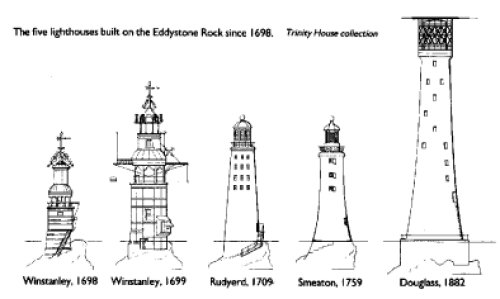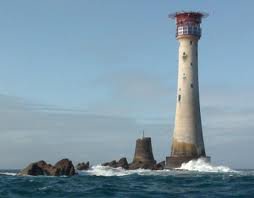

Tel: (01736) 786900
Email: enquiries@trinityhouse.co.uk
Web: www.trinityhouse.co.uk/lighthouses-and-lightvessels/eddystone-lighthouse
Map
The most famous lighthouse in the British Isles is probably the Eddystone, built on a small and very dangerous rock 13 miles south-west of Plymouth and eight miles south of Rame Head.
There have been four separate lighthouses built here. The original tower, completed in 1698, was the first lighthouse to be built on a small rock in the open sea.
Winstanley's Tower 1698 - 1703
The first attempt to render the Eddystone safe to shipping was by an eccentric named Henry Winstanley. As a showman he had established "Winstanley's Waterworks" near Hyde Park which remained one of London's foremost popular attractions for decades. As a merchant he had invested money in five ships and when for the second time, one was wrecked on the Eddystone, Winstanley promised to rid shipping of this menace. In 1696 he commenced work on a wooden structure and finding conditions considerably harder than he had envisaged doubtless began to wonder what he had let himself in for however the work progressed steadily.
England was at war with France at this time and such was the importance of the Eddystone project that the Admiralty provided Winstanley with a warship for protection on the days when work was taking place. In 1697 a most unusual incident occurred; one morning at the end of June the protective vessel did not arrive but in its stead a French privateer which carried Winstanley off to France. However when Louis XIV heard of the incident he ordered that Winstanley be immediately released saying that "France was at war with England not with humanity". The importance of the Eddystone was now international. The lighthouse survived its first winter but was in need of repair, and was subsequently changed in 1699 to a dodecagonal (twelve sided) stone clad exterior on a timber framed construction with an octagonal top section. Winstanley's tower lasted until the Great Storm of 1703 erased almost all trace on 27th November. Winstanley was on the lighthouse, completing additions to the structure. No trace was ever found of him, or of the other five men in the lighthouse.
The cost of construction and five years' maintenance totalled £7,814 7s.6d, during which time dues totalling £4,721 19s.3d had been collected at one penny per ton from passing vessels.
Rudyerd's Tower 1709 - 1755
The next man to get a patent charter for the Eddystone was a Captain Lovett who acquired the lease of the rock for 99 years, and by an Act of Parliament he was allowed to charge all ships passing a toll of 1d per ton, both inward and outward. His designer was a man named John Rudyerd, who was a silk mercer on Ludgate Hill; the trade of scientist or engineer did not really exist then and problems relating to those fields were approached by people as hobbies rather than professions. It seems remarkable that such a person with no experience or proven knowledge of the subject should be selected to undertake such a difficult and dangerous task. Taking a shipbuilder's rather than a house builder's approach he came up with a design based on a cone instead of Winstanley's octagonal shape. His final wooden tower, lit in 1709, proved much more serviceable and at last it seemed the problem had been solved - a lighthouse had been permanently established at the Eddystone built by one of the greatest amateurs.
The lighthouse stood for 47 years. On the night of 2nd December 1755, the top of the lantern caught fire, probably through a spark from one of the candles. Henry Hall, the keeper on watch, who was 94 years old but said to be 'of good constitution and active for his years', did his best to put out the fire by throwing water upwards from a bucket. While doing so, the leaden roof melted, his mouth was open whilst looking up and some of the molten lead ran down his throat. He and the other keeper battled continuously against the fire but they could do nothing as the fire was above them all the time - as it burnt downwards it gradually drove them out onto the rock. The fire was observed from the shore by a Mr. Edwards, 'a man of some fortune and more humanity'. The old account says, he sent off a boat which arrived at the lighthouse at 10am after the fire had been burning for eight hours. The sea was too rough for the boat to approach the rock so they threw ropes and dragged the keepers through the waves to the boat. The lighthouse continued to burn for five days and was completely destroyed.
Henry Hall lived for 12 days after the incident, and a Doctor Spry of Plymouth who attended him made a post-mortem and found a flat oval piece of lead in his stomach which weighted 7 ounces 5 drams. Dr. Spry wrote an account of this case to the Royal Society, but the Fellows were sceptical as to whether a man could live in this condition for twelve days. This so incensed him that, for the sake of his reputation, he performed many experiments on dogs and fowls pouring molten lead down their throats to prove that they could live.
Smeaton's Tower 1759 - 1882
After experiencing the benefit of a light for 52 years, mariners were anxious to have it replaced as soon as possible. Trinity House placed a light vessel to guard the position until a permanent light could be built. In 1756 a Yorkshireman, John Smeaton, who had been recommended by the Royal Society, travelled to Plymouth on an assignment which was to capture the imagination of the world. He had decided to construct a tower based on the shape of an English Oak tree for strength but made of stone rather than wood. For such a task he needed the toughest labourers, and many of the men employed had been Cornish Tin Miners. Press ganging had become a problem amongst the workforce, so to ensure that the men would be exempt from Naval Service, Trinity House arranged with the Admiralty at Plymouth to have a medal struck for each labourer to prove that they were working on the lighthouse.
Local granite was used for the foundations and facing, and Smeaton along with William Cookworthy invented a quick drying cement, essential in the wet conditions on the rock, the formula for which is still used today. An ingenious method of securing each block of stone to its neighbour, using dovetail joints and marble dowels was employed, together with a device for lifting large blocks of stone from ships at sea to considerable heights which has never been improved upon. Using all these innovations, Smeaton's tower was completed and lit by 24 candles on 16th October 1759. In 1877 cracks appeared in the rock under the lighthouse and caused it to shake from side to side whenever large waves hit, so the top half of the tower was dismantled and re-erected on Plymouth Hoe as a monument to the builder. The remaining stump still stands on the Eddystone Rock. Smeaton's lighthouse was 59 feet high and had a diameter at the base of 26 feet and at the top of 17 feet. In 1782 an oil-fed wick was used for the first time.
In 1807 the 100-year lease on the lighthouse expired, whereupon ownership and management devolved to Trinity House. In 1810 they replaced the chandelier and candles with 24 Argand lamps and parabolic reflectors.
Douglass's Tower - 1882 Onwards
No time was lost in building another lighthouse on the rocks, and the task of building a new tower gave ample opportunity to incorporate many of the latest ideas in lighthouse construction, which by 1877 had become a much more refined business, largely due to the efforts of Robert Stevenson, who developed Smeaton's idea and contributed many of his own. Douglass used larger three ton stone blocks, dovetailed not only to each other on all sides but also to the courses above and below, and in 1882 the present Eddystone Lighthouse was completed and opened by the Duke of Edinburgh, who laid the final stone of the tower which is 161 feet tall. In 1901 the adoption of a pressurised oil feed combined with an incandescent mantle tripled the previous light output. The light was altered from oil burning to electric power in 1956. The fog signal was altered from a bell to an explosive sound and then to electronic sound emitter.
This was the first Trinity House rock lighthouse to be converted to automatic operation. To enable the work to be carried out a helipad was built above the lantern. The automation was completed and the light reintroduced on 18th May 1982, 100 years to the day since the opening of Douglass's tower by the Duke of Edinburgh.
Eddystone Lighthouse is now monitored and controlled from the Trinity House Operations Control Centre at Harwich in Essex.

Cornish Lighthouses Cornwall's Shipwrecks Rame Head The Coastal Footpath